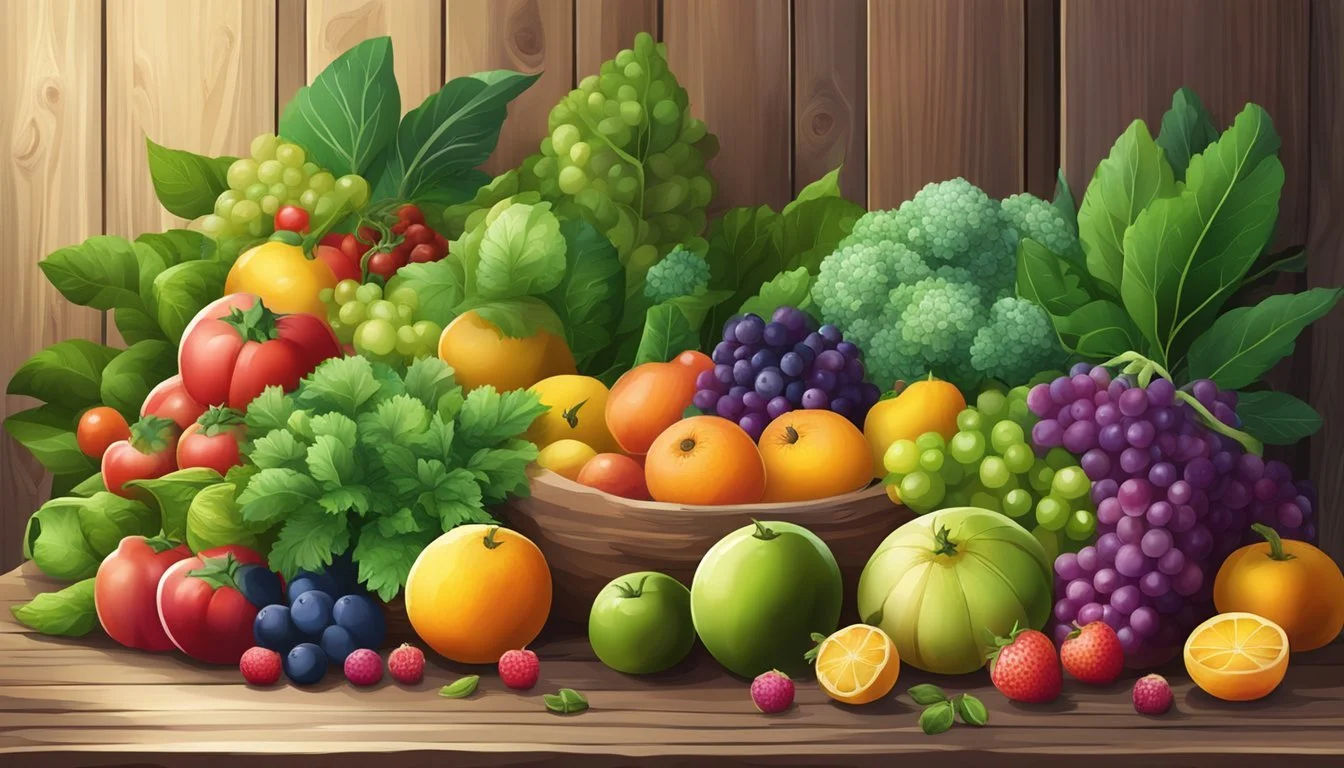Rhode Island Seasonal Fruit & Vegetables in May
Your Fresh Guide
This Article is Part of our Rhode Island Seasonal Fruit & Veg Calendar
In Rhode Island, the arrival of May heralds the transition from the sparse produce of winter to the abundant variety that spring and summer promise. This is a time when the state's fields and orchards begin to flourish, offering a fresh bounty that's reflective of the region's agricultural rhythm. Seasonal eating not only captures the peak flavors of fruits and vegetables but also supports local farmers and minimizes the environmental impact of long-distance food transport.
May in Rhode Island marks the availability of fresh, local produce commencing with the early harvests of the season. Consumers can look forward to the arrival of ripe strawberries, a crowd favorite, heralding the start of the state’s berry season. Alongside these sweet treats, the vegetable plots yield tender greens such as spinach (What wine goes well with spinach?) and lettuce, as well as the crisp, earthy flavors of radishes, which are all emblematic of the spring harvest.
For those keen on sourcing seasonally and regionally, Rhode Island's farmers' markets become increasingly vibrant with an array of colors and textures. Asparagus (What wine goes well with asparagus?), another springtime staple, begins to peak, offering a versatility that's appreciated by both home cooks and professional chefs. Meanwhile, the continuation of greenhouse-grown herbs and the last of the stored root vegetables from winter provide a bridge between the seasons, allowing for a variety of fresh local dishes to be prepared.
Overview of Rhode Island's Growing Season
In Rhode Island, May marks a transitional period in the growing season where temperatures begin to warm up, preparing the ground for summer crops. This shift in season comes with weather changes that significantly affect planting and harvesting times.
Transition from Spring to Summer
During May, Rhode Island's growing season steadily moves from the cool, damp conditions of spring towards the warmer and more temperate climate of summer. Gardeners and farmers typically finish planting the last of their spring vegetables and begin to prepare for the heat-loving summer crops. Early in the month, one can still sow seeds of cool-season crops, such as lettuce and peas, but it's also time to start thinking about the warm-season vegetables that will be planted once the threat of frost has passed.
Typical Weather Patterns in May
May's weather in Rhode Island is characterized by rising temperatures and a decrease in the occurrence of frost. Average daytime temperatures can range from 60°F to 70°F, creating favorable conditions for growth. By mid to late May, the chance of frost generally subsides, giving way to warmer evenings that are beneficial for newly planted summer crops.
Average High Average Low Precipitation 70°F 50°F 3-4 inches
Farmers closely monitor the local frost dates and soil temperatures to ensure the successful germination and growth of their crops during this transitional month.
Key Fruits and Vegetables in May
In Rhode Island, May marks the arrival of several key fruits and vegetables that are fresh and at their peak of flavor.
Fruit Highlights
Strawberries: May welcomes the harvest season for strawberries, a local favorite, known for their vibrant red color and sweet flavor.
Rhubarb: Often paired with strawberries, rhubarb is another fruit that hits its stride in May, offering a tart component for desserts and compotes.
Vegetable Highlights
Asparagus: Asparagus stalks are freshly picked during May, offering a versatile vegetable option known for its tender shoots and nutritious profile.
Peas: This is the time for fresh, sweet peas to be harvested, which can be enjoyed in a variety of dishes or simply on their own.
Local Farming Practices
Rhode Island farmers are committed to providing fresh, locally-sourced produce through sustainable and organic methods. Consumers benefit from a variety of fruits and vegetables grown with a focus on environmental stewardship and health.
Sustainable Agriculture
Sustainable agriculture in Rhode Island emphasizes the production of food in a way that maintains the health of the local environment and community. Farmers adopt practices that promote soil health, water conservation, and biodiversity. Crop rotation and the use of cover crops are common practices to preserve soil nutrients and prevent erosion. Local farms often operate on a smaller scale, which allows for more attentive land management and reduces the reliance on synthetic fertilizers and pesticides. Rhode Island's sustainable farms aim to produce high-quality food while ensuring that their farming methods can be sustained for future generations.
Organic Farming
Organic farming is a crucial aspect of Rhode Island's agricultural scene, with many farms adhering to organic standards to produce their fruits and vegetables. These farms avoid the use of synthetic pesticides, herbicides, and fertilizers, opting for natural alternatives that are safer for both consumers and the environment.
Soil Management: Organic farms typically employ techniques such as composting and the use of organic matter to enrich the soil.
Pest Control: Biological pest control methods, including the introduction of beneficial insects and manual removal of pests, are preferred.
Certification: To be labeled as organic, farms must be certified by recognized organizations, ensuring that they meet strict guidelines on their farming practices.
Local organic produce is sought after for its quality and the peace of mind that comes from knowing it was grown without harmful chemicals.
Rhode Island Farmers Markets
Rhode Island farmers markets become vibrant hubs in May, showcasing a variety of fresh and local produce. At these markets, shoppers gain access to the season's freshest fruits and vegetables, experiencing the community's commitment to sustainability and local agriculture.
Shopping for Seasonal Produce
Patrons visiting Rhode Island farmers markets in May can expect an abundance of seasonal offerings. The markets operate under organizations like Farm Fresh RI, ensuring produce is at its peak of freshness. Shoppers can follow a simple guideline when seeking out the season's best:
Fruits: Strawberries begin to come into season, offering juicy and ripe flavors.
Vegetables: Asparagus, greens like spinach and kale, and root vegetables like radishes are commonly found.
It's advisable for consumers to arrive early for the best selection, as the most sought-after items can sell out quickly.
Supporting Local Economy
Every dollar spent at a local farmers market contributes directly to the Rhode Island economy. The markets not only provide a venue for local farmers and producers to sell their products, but they also:
Encourage the growth of Rhode Island's agricultural sector.
Foster relationships between growers, artisans, and community members.
Support Farm Fresh RI's mission to connect the local community with local food systems.
Consumers can take pride in knowing that their purchases help sustain the livelihoods of local farmers and contribute to a healthier, locally-driven food system.
Selecting and Storing Fresh Produce
In May, Rhode Island's markets brim with fresh produce. Knowing how to select and store items like berries, tomatoes, lettuce, and spinach ensures longevity and flavor.
Tips for Picking Fresh Fruits and Vegetables
When selecting berries, look for bright, firm fruits with a uniform color. They should be free from mold and not packed too tightly, as pressure can cause bruising. With tomatoes, choose those with a vibrant color and slightly firm touch. They should have a fragrant scent, especially at the stem.
For leafy greens such as lettuce and spinach, the leaves should be crisp and vibrant without any signs of wilting or discoloration. It is important to inspect the leaves carefully for any signs of insects or decay, especially on the undersides and in the inner part.
Proper Storage Techniques
Once home, proper storage techniques can extend the life of your produce. Berries should be refrigerated and kept in a moisture-proof container. They are delicate; avoid washing them until just before use to prevent mold growth.
Tomatoes fare best at room temperature away from sunlight, allowing them to ripen to perfection. Refrigeration can make their texture mealy, so this should be avoided until they are fully ripe and only if not consumed promptly.
Store lettuce and spinach in the refrigerator. They should be kept in the crisper drawer wrapped in paper towels to absorb excess moisture, which can accelerate decay. Ensure the bags are loosely packed to allow for air circulation.
Health Benefits of Seasonal Eating
Consuming seasonal produce in May offers peak freshness and nutrient density. This choice supports a healthier lifestyle with tangible benefits for one's body and overall well-being.
Nutritional Advantages
Seasonal fruits and vegetables harvested in May have reached their optimal nutritional value. They are often richer in vitamins, minerals, and antioxidants when compared to out-of-season produce, which can lose some nutritional content due to longer storage times and transport. For example, leafy greens like spinach, which are in season in May, provide high levels of iron, vitamin C, and folate. Eating these items fresh ensures maximal retention of these vital nutrients.
Seasonal Eating Impact on Well-being
Eating seasonal produce from Rhode Island also supports overall well-being. It encourages a varied diet that can enhance the immune system and may also help to cleanse the body naturally. For instance, consuming fresh, seasonal pumpkins in May provides a boost to the immune system and supports liver health, as they are packed with vitamins A and C, as well as fiber and potassium. Adopting a seasonal diet also tends to incorporate a wider range of produce, thus reducing the reliance on processed foods and fostering a holistic approach to health.
Recipes and Preparation Ideas
In May, Rhode Island's seasonal produce provides a bounty of flavors that can be transformed into delectable dishes or preserved to extend their enjoyment. Below are some practical ways to make the most of these ingredients through cooking and preserving.
Simple Seasonal Dishes
For those who love to cook, May's harvest allows for the creation of simple, yet flavorful meals. Utilizing fresh herbs (how long do fresh herbs last?) enhances the natural tastes of vegetables and fruits.
Salads: Toss tender lettuce, peppery arugula, and sweet spinach with a simple vinaigrette. Incorporate herbs like parsley or thyme for an aromatic touch.
Grilled Vegetables: (What wine goes well with grilled vegetables?) Vegetables like asparagus and scallions can be lightly grilled with a drizzle of olive oil and a sprinkle of sea salt (how long does sea salt last?). Finish with fresh lemon verbena for a zesty note.
Roasted Radishes: Transform piquant radishes by roasting them with honey until they're tender and sweet.
Strawberry Desserts: May's strawberries can be featured in desserts— from simple strawberry salads to more intricate tarts, sweetened naturally with honey.
Preserving Seasonal Flavors
Preserving is a wonderful method to extend the life of seasonal produce well beyond their natural harvest.
Herb-infused Oils: Capture the essence of herbs like rosemary and oregano by infusing them into olive oil, storing the flavors for future culinary use.
Pickling: Vegetables such as radishes, carrots, and cucumbers can be pickled to retain their crunch and tanginess.
Freezing Herbs: Fresh herbs can be chopped and mixed with water or oil, then frozen in ice cube trays. These can be dropped into soups and stews to add a burst of flavor.
Jam-making: Turn ripe strawberries into a delightful jam with a hint of mint or lemon verbena for an original twist.








